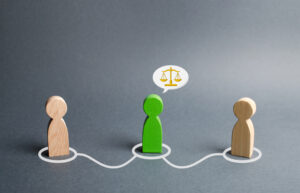Mediation Explained Fully
Ultra simplified definition: Mediation is to be in the middle to help people agree.

This is what that looks like and it is definitely an oversimplification of what can be a profound experience that is lifechanging for all involved.
Standard definition: “intervention between conflicting parties to promote reconciliation, settlement, or compromise”

This is problematic. You should almost never intervene with force and sometimes allowing a small amount of conflict to poke through can help move towards eventual resolution.
But both of these definitions are lacking. Mediation comes from a root word that means to be in the middle. In service of that goal, the essential attributes of a mediator are:
- impartiality.
- the ability to confront truth comfortably.
- the ability to direct attention towards truth and ask someone to see it.
- the ability to ask someone to make a decision that is entirely their decision without judgement.
A mediator must start, and remain, unbiased despite the topic and despite the viewpoints involved. A skilled mediator can handle emotional outbursts, difficult topics, and anger without letting themselves get enmeshed in the conflict. This makes it possible for them to fully understand all viewpoints so that resolution is achieved for everyone.

Please understand the full depth of that. A mediator, acting in that capacity, must stare in the face of violence, insanity, racism, sexism, and trauma and keep as calm as a placid lake while not even considering the implications of what is being said or felt but rather focusing only on finding a place where a viewpoint might shift slightly towards the other side and without asking for that shift but only pointing out that the opportunity is there while leveraging the desire for resolution by both parties.

A mediator acting in that capacity is actually unwelcome in a standard setting. Groups form around agreements and any deviation from those agreed upon viewpoints is rejected to some degree – in relation to how important the viewpoints are to the group – and acceptance into the group is predicated on the idea of disagreeing very carefully. A mediator must therefore act in a capacity that is wholly unnatural to human beings. And the ability to do that may be limited for some. Some mediators can stand in the middle and be unbiased in the face of a nazi trying to mediate a dispute with a person of color. Most could not, and possibly should not.

I will also point out that there are many kinds of mediation, and in some mediation you do argue, fight, cajole, incite or direct people towards “better” viewpoints. But those kinds of mediations are rare and with good reason. Their workability is incredibly niche and without a court enforcing the agreement the agreements rarely last. In these scenarios however the definitions do broaden.
It must also be understood that mediation is not all about disputes, despite what the dictionary might tell you. Mediation is the effort to bring clarity to agreement, to find and identify any and all shared agreement and align emotions to newly formed mutual agreement and to find a path despite feelings around remaining disagreement. The time spent is mostly on clarifying the agreements. But the most important part is in aligning emotions. This is where people connect. Human beings find love within the space of a shared reality and mediation sets the space for that to be possible. This is essential for all people whether in a family or on a team or in a business whether new or long time friends.

And that is where the dictionary falls short. Mediation sits in a place between therapy and contract negotiation. And it is valuable to people who are in the bliss of a new love or the Hatfields and Mccoys.

